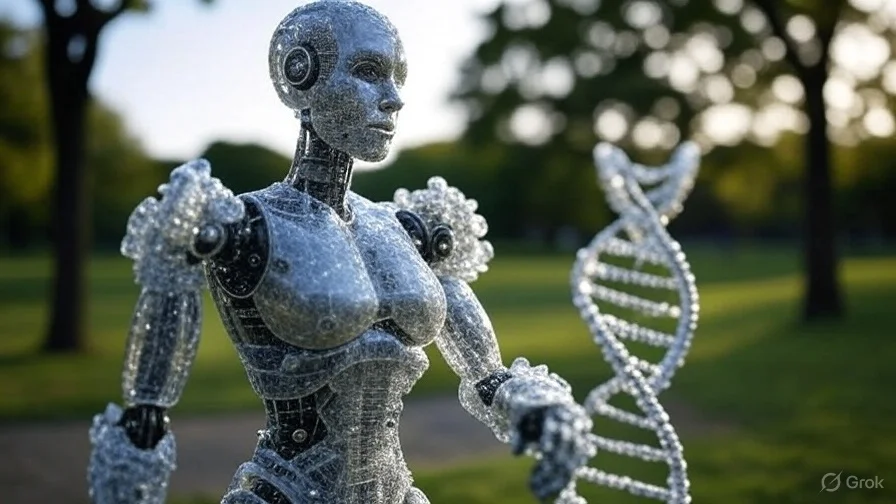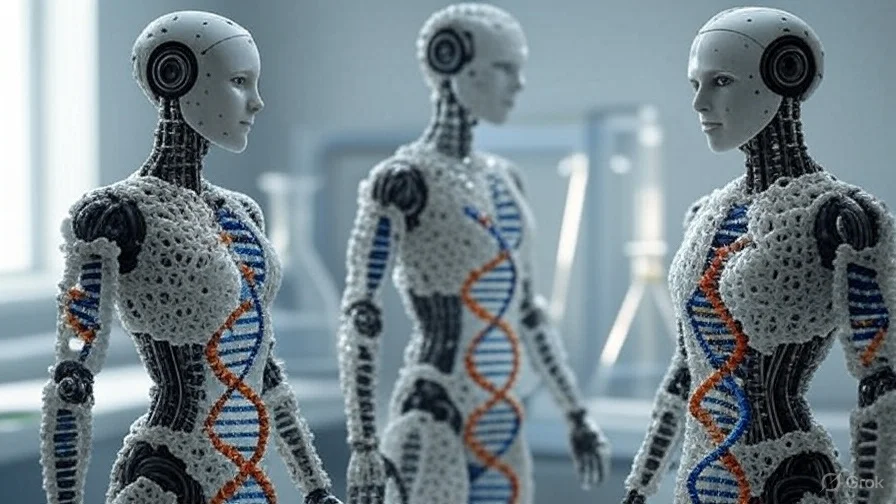Imagine a future where microscopic machines patrol our bodies, tirelessly seeking out and neutralizing diseases at their source. This isn’t science fiction; it’s the promise of DNA-based nanorobotics, a burgeoning field poised to revolutionize medicine. These tiny robots, built from the very building blocks of life, are showing incredible potential for targeted drug delivery, disease detection, and even cancer treatment. This article delves into the fascinating world of these molecular machines, exploring their construction, capabilities, and the groundbreaking impact they could have on our health.
The Building Blocks of Life: Why DNA?
DNA, the iconic double helix, is more than just the blueprint of life. It’s an incredibly versatile material with unique properties that make it ideal for building nanorobots. Its inherent ability to self-assemble into complex structures is key. Scientists can program DNA strands to bind together in specific ways, creating intricate shapes and structures with remarkable precision. This precision is what allows for the creation of nanobots capable of performing complex tasks at a cellular level.
Furthermore, DNA is biocompatible. This means that it is unlikely to be rejected by the body, a critical factor when considering medical applications. The body already recognizes and processes DNA, minimizing the risk of adverse immune responses. This inherent compatibility makes DNA-based nanorobots a promising avenue for delivering therapeutic agents directly to diseased tissues, such as cancerous tumors.
The adaptability of DNA also plays a crucial role. Researchers can manipulate DNA sequences to create nanobots with specialized functionalities. For instance, a nanobot might be designed to recognize and bind to specific cancer cells or to release medication only when triggered by a particular signal. This level of control and specificity opens up unprecedented possibilities for personalized medicine.
Designing the Nanobots: Cubes, Vesicles, and Nanowires
The construction of these molecular machines is a delicate and complex process. Researchers are experimenting with different designs and assembly methods to create nanobots with specific functions. One of the early approaches involved building DNA modules, similar to Lego bricks, that could be assembled to perform different tasks.
Initially, scientists focused on creating cube-shaped DNA modules. Each cube would be designed with a specific function, such as detecting viruses or delivering therapeutic drugs. Other modules could transmit information between components, similar to how a computer processes data. The goal was to create a versatile nanobot that could recognize and respond to various stimuli in the body.
While the concept of assembling these DNA “Lego bricks” in a laboratory environment seemed promising, the practical application proved challenging. The complex nature of working at the nanoscale presented significant hurdles. The process of assembling these modules within a human body is an even greater feat.
A slightly different approach utilized vesicles, which are small, bubble-like structures made of fats and organic materials. These vesicles act as a chassis, or a base, for the nanobots. The DNA modules can be attached to the surface of the vesicle, giving them a specific functionality. This approach proved to be more practical than assembling the modules directly.
To further enhance the functionality of these nanobots, researchers have developed nanowires that transmit information between the DNA modules. These nanowires function like a nervous system, allowing the modules to communicate and coordinate their actions. This integrated system allows the nanobots to perform complex tasks, such as targeting and destroying cancer cells.
How DNA Nanobots Work: Targeted Delivery and Disease Detection
The primary goal of DNA nanobots is to interact with cells and tissues in a highly targeted manner. They can be programmed to identify specific targets, such as cancer cells or viruses, using various recognition mechanisms.
Once a nanobot has found its target, it can initiate a specific action. For instance, nanobots designed to fight cancer may release chemotherapy drugs directly to the tumor cells, minimizing the impact on healthy cells. They can also trigger the self-destruction of cancer cells, a process called apoptosis.
Beyond treatment, DNA nanobots show great potential for disease detection. These nanobots can be designed to recognize specific biomarkers associated with a disease. For example, they could detect the presence of unique proteins or genetic markers indicating early-stage cancer. This would enable earlier diagnosis and more effective treatment.
By employing this technology, we may see a reduction in the need for invasive diagnostic procedures, improving the patient experience, and allowing for earlier interventions. The ability to diagnose diseases at the molecular level could fundamentally alter the way healthcare is delivered.
The Challenges and Hurdles Ahead
Despite the immense promise, DNA-based nanorobotics is still in its early stages. Several challenges must be addressed before these nanobots become a reality in clinical settings.
One major hurdle is the complexity of working at the nanoscale. The design, construction, and control of nanobots require sophisticated techniques and precise manipulation of molecular components. Furthermore, the conditions within the human body, such as temperature, pH levels, and the presence of enzymes, can affect the stability and functionality of these tiny machines.
Another challenge is the delivery and targeting of nanobots. Getting these molecular machines to the correct location within the body and ensuring they effectively interact with their targets is crucial. Researchers are working on innovative strategies to improve the navigation and targeting capabilities of nanobots.
The potential for unforeseen side effects and long-term health consequences must also be thoroughly evaluated. Thorough testing and regulatory approval are essential before these technologies can be used in humans. The body’s immune system may recognize these nanobots as foreign objects, triggering an immune response. Therefore, researchers must design nanobots that minimize this risk.
Finally, the cost of production and the scalability of manufacturing nanobots are significant factors. If DNA nanobots are to become widely available, they must be produced efficiently and cost-effectively.
The Promise of Personalized Medicine
The potential of DNA nanobots to revolutionize medicine is vast. They pave the way for personalized treatments, tailored to an individual’s unique genetic makeup and disease characteristics. By delivering drugs directly to the site of disease, nanobots could minimize side effects and enhance treatment efficacy.
Moreover, the ability to detect diseases at their earliest stages could significantly improve patient outcomes. Early detection allows for timely intervention, increasing the chances of successful treatment and recovery.

Consider the implications for cancer treatment. Nanobots could be programmed to seek out and destroy cancer cells while sparing healthy tissues. This targeted approach could reduce the debilitating side effects associated with traditional chemotherapy and radiation therapy. In the future, nanobots may even be used to repair damaged tissues and organs.
The potential applications extend beyond cancer treatment. Nanobots could be used to treat infectious diseases, autoimmune disorders, and genetic conditions. These technologies could also be used to develop new diagnostic tools and personalized drug delivery systems, ushering in a new era of precision medicine.
Current Advancements and Future Directions
Significant progress is being made in the field of DNA nanorobotics. Researchers have demonstrated the ability to build various types of nanobots with different functionalities. Some nanobots have been designed to encapsulate and deactivate viruses, while others can release drugs in response to specific stimuli.
The development of advanced imaging techniques has also been critical. These techniques allow researchers to visualize nanobots in action, providing valuable insights into their behavior and performance within living systems.
Future research will likely focus on enhancing the precision, efficiency, and safety of DNA nanobots. Scientists are exploring new materials and designs to improve the stability and biocompatibility of these machines. They are also working on developing sophisticated control systems that will allow for greater control over the behavior of nanobots within the body.
A key area of research is the development of smarter nanobots that can respond to multiple stimuli and adapt to changing conditions. The integration of artificial intelligence and machine learning could further enhance the capabilities of these molecular machines, enabling them to perform complex tasks and make intelligent decisions.
The Ethical Considerations
The development and application of DNA nanorobotics raise important ethical considerations. One key area of concern is the potential for misuse of this technology. As nanobots become more sophisticated, there is a risk that they could be used for malicious purposes.

The potential impact on privacy is also a concern. Nanobots could potentially collect sensitive information about an individual’s health and genetic makeup. Protecting this data and ensuring its responsible use is crucial.
Another ethical consideration is the potential for unequal access to these technologies. If DNA nanorobots are expensive to produce, they may only be available to those who can afford them, exacerbating existing health disparities.
These ethical implications must be carefully considered as DNA nanorobotics move from the research lab to clinical practice. Clear guidelines and regulations are needed to ensure that this powerful technology is used responsibly and for the benefit of all.
Beyond Medicine: Applications in Other Fields
While the primary focus of DNA nanorobotics is medicine, the technology has potential applications in other fields. In environmental science, for example, nanobots could be used to detect and remove pollutants from water and soil.
In materials science, DNA nanobots could be used to create new types of materials with unique properties, such as self-healing coatings and advanced sensors.
The ability of DNA to self-assemble and form complex structures has broad implications. Researchers are exploring its use in fields ranging from electronics to energy.
The Path to the Future
The journey of DNA nanorobotics from concept to clinical application is a long one. Despite the challenges, the potential benefits are too significant to ignore. Scientists worldwide are pushing the boundaries of this innovative technology, driven by the promise of transforming healthcare.
As this field continues to evolve, it is essential to foster collaboration between researchers, clinicians, ethicists, and policymakers. This collaborative approach will help ensure that DNA nanorobotics are developed and used in a way that maximizes their benefits while minimizing potential risks.
The future of medicine may very well involve microscopic machines working tirelessly within our bodies, providing early diagnosis, targeted treatments, and a new level of health. The vision of nanobots is ambitious, but the potential rewards – healthier lives, prolonged longevity, and a profound understanding of the human body – are worth the pursuit. For more on how to maintain a healthy lifestyle and potentially boost your lifespan, see our article on Healthy Aging: Proven Strategies for a Vibrant and Fulfilling Life and also consider how important it is to understand the New Alzheimer’s Blood Test Could Revolutionize Diagnosis: A Detailed Guide.
Summary: The Nanobot Revolution is Coming
The creation of DNA-based nanorobots is a monumental achievement in scientific research. These microscopic machines hold the key to unprecedented advancements in healthcare. As our understanding of DNA and nanotechnology grows, we are one step closer to a world where diseases are treated at the molecular level. While challenges remain, the potential to revolutionize medicine and enhance human health is undeniable. From targeted drug delivery to early disease detection, these tiny robots represent a giant leap towards a healthier and brighter future. Consider all of these advances and ways to help your health. You can always improve your mobility and health by considering articles such as Boost Spinal Mobility: 3 Yoga Poses for Flexibility and Health and **30-Minute Walking Workout: Maximize Calorie Burn and Boost














Post Comment